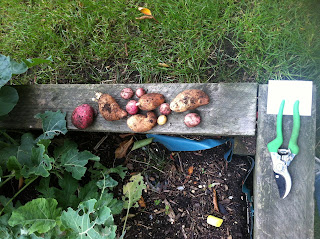I have recently started volunteering at the wonderful site that is Urban Veg,
a whole acre within the gorgeous Winterbourne Botanical Gardens.
With so much space and a patch of ground that needs a crop, I was inspired to suggest quinoa, rainbow quinoa to be exact. I know Real Seeds can provide the seeds, I've never grown it before (so there's the adventure of growing something a bit different) and the idea of this multi coloured super food crop is both beautiful, nutritious and something I'm really eager to try.
So far I've been asking a few friends who've grown it before what they're experiences are. Fiona (Viveka Gardens) said that it was OK to germinate but went really leggy before planting out despite putting tin foil underneath their pots (to try and counteract the leaning towards the light effect). Fiona blogged about Quinoa earlier in the year.
At the Urban Veg garden on Sunday, we pondered over the instructions - puzzled as to why Realseeds suggest sowing seeds as late as May on the seed packet.
We wondered whether the reason was due to daylight sensitivity, after all they originate from the Andes. Cool in temperature but quite close to the equator.
From my many recent twitter discussions (thank you to all who shared their experiences) I think it may be to avoid planting out very leggy, pale seedlings.
However, the scientist in me wants to run an experiment of planting a few seeds weekly from March (to test which is the best time to sow in the UK) and then plant out the best seedlings in final growing position in late May/early June depending on how favourable the weather is next summer.
In any case, when I start growing quinoa I'm sure my vast experience of growing chard will come into play as it is a fellow chenopod favouring similar growing conditions and an alkaline soil.
Any quinoa tips would be massively appreciated before we venture into our very own quinoa experiment next Spring.
With so much space and a patch of ground that needs a crop, I was inspired to suggest quinoa, rainbow quinoa to be exact. I know Real Seeds can provide the seeds, I've never grown it before (so there's the adventure of growing something a bit different) and the idea of this multi coloured super food crop is both beautiful, nutritious and something I'm really eager to try.
So far I've been asking a few friends who've grown it before what they're experiences are. Fiona (Viveka Gardens) said that it was OK to germinate but went really leggy before planting out despite putting tin foil underneath their pots (to try and counteract the leaning towards the light effect). Fiona blogged about Quinoa earlier in the year.
At the Urban Veg garden on Sunday, we pondered over the instructions - puzzled as to why Realseeds suggest sowing seeds as late as May on the seed packet.
We wondered whether the reason was due to daylight sensitivity, after all they originate from the Andes. Cool in temperature but quite close to the equator.
From my many recent twitter discussions (thank you to all who shared their experiences) I think it may be to avoid planting out very leggy, pale seedlings.
However, the scientist in me wants to run an experiment of planting a few seeds weekly from March (to test which is the best time to sow in the UK) and then plant out the best seedlings in final growing position in late May/early June depending on how favourable the weather is next summer.
In any case, when I start growing quinoa I'm sure my vast experience of growing chard will come into play as it is a fellow chenopod favouring similar growing conditions and an alkaline soil.
Any quinoa tips would be massively appreciated before we venture into our very own quinoa experiment next Spring.
.JPG)














































